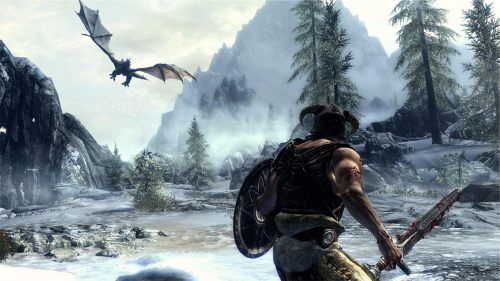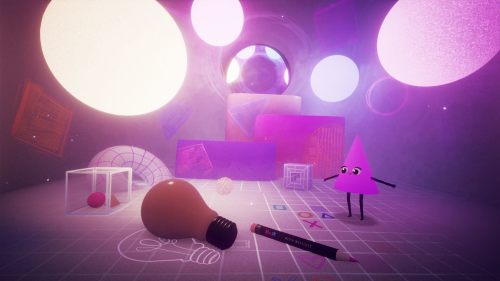PlayStation VR Review: An Imperfect Glimpse At The Future
It’s hard to overstate how eye-opening good virtual reality is.
VR’s sense of presence, of being able to naturally look and move around and interact with virtual environments, is wonderful in the true sense of the word. VR transforms genres like shooters from button-heavy stick-twiddlers into elegant and intuitive experiences, while opening up entirely new genres for developers. I’ve seen VR make seasoned gamers and the game-phobic alike giddy with glee. My mum can’t stand video games, but ask her about VR and she’ll wax lyrical about its transportative potential.
Sony’s PlayStation VR headset is the first product in the field that matches decent quality with ease of use and a price point that, while not cheap, is more accessible than the PC-based competition. It’s not the best product on the market, and it’s not the cheapest, but it’s the best balance there is right now. Is it the right balance for you?
Setting up the PSVR seems daunting. Cables snake out from the box like tentacles from Cthulhu’s butt, and if you’re getting the (required) PS Camera at the same time, well, that’s one more. It’s what my grandmother would have referred to as “a bit of a rat’s nest.” But the absurdly clear guidebook knocks the initial setup process to maybe five minutes tops. Best of all: the byzantine calibration and recalibration of the Rift or Vive are nowhere to be seen; plug it in, turn it on, and it just works, and most calibration issues can be solved with a single button press.
Wearing the headset is just as easy: it sat comfortably and snugly on the heads of everyone with whom I demoed it. Your first taste of VR will likely be the PlayStation home menu, which appears, as does all 2D content, as a giant TV screen suspended in darkness. The image is noticeably but not cripplingly low-resolution; on the other hand, by using a full RGB panel (as opposed to the Rift's PenTile displays), Sony has largely relegated the “screen-door” effect (where the edges of individual pixels form a distracting grid) to a barely noticeable layer of grain. The PSVR is full of such compromises designed to bring the system into a consumer-friendly price range, and they mostly work.
Positional tracking on the PSVR isn’t perfect. The PlayStation Camera can only see the system’s tracking lights within a reasonably ample, shoebox-shaped playing area; depending on your setup, it can lose the headset or controllers when reaching too far - an infuriating scenario when a game mandates that you reach that little bit further. Face away from the the camera, and controller tracking goes out the window - it can’t track what it can’t see. On one occasion, my headset and controller tracking went completely off, snapping sickeningly from location to location without any input, but that issue was solved by restarting the PS4.
For all its technical compromises, PlayStation VR largely works because its best games are designed around its limitations. Sony sent me a fairly wide range of games (and I’d already played Superhypercube at Fantastic Arcade last year), so I tried to sample them all as best I could. My results were...mixed.
The biggest blockbuster of the PSVR launch titles, Batman: Arkham VR, is a handsome, entertaining short story in the continuity of Rocksteady’s popular series, seeing players investigate a crime through a number of static detective scenes. Rocksteady did amazing things with the hardware to bring its vision to PSVR with such fidelity, and its motion controls are intuitive and fun. One segment towards the end truly demonstrates the dramatic power of the medium, creating a terrifying, immersive psychological horror atmosphere that probably wouldn’t work in a traditional game. There’s not much to Arkham VR, but what there is is bloody terrific. Plus, you can make Batman dance. Prince would be proud.
Sony’s PlayStation VR Worlds, a glorified demo app heavily promoted in its advertising, is a solid collection of minigames that show off a variety of uses for VR. There’s an atmospheric and terrifying shark-cage experience; a 3D Breakout clone using the headset as a paddle; a dizzying space shooter; and a downright awful luge game. But the crowning achievement of VR Worlds - and one of the better PSVR experiences available right now - is The London Heist, a gangster tale built around gunplay and Cockney accents. It’s unspeakably cool as a demo, and delivered a revelatory moment wherein I was getting peppered with bullets before realising I could physically duck down and shoot from under the desk in front of me. My friend Dave did the same, then tried using the virtual desk to get back to his feet. It didn’t work. Poor Dave.
Until Dawn: Rush of Blood was a surprise hit for me. Unlike its narrative-driven predecessor, Rush of Blood is an on-rails shooter - literally, as it takes place on roller coaster tracks in a killer-infested theme park. Hosted by writer, horror savant, and Fantastic Fest regular Larry Fessenden, it’s a fairly simple target-shooter laden with escalatingly difficult creature encounters, using the PS Move controllers as guns. It’s also a really well-designed example of such a shooter, with a ghoulish sense of humour, unsettling environmental design and animation, and plenty of spook-a-blast action. Nothing at all like Until Dawn itself, then, but a lot of fun nonetheless.
My favourite for all the wrong reasons, Resident Evil 7’s free “Kitchen” demo is a brief, mostly non-interactive horror experience. It’s also rendered unintentionally hilarious by the player’s ability to physically stand up in a game meant to be played seated. Being able to look back at your still-seated body, when you’re clearly not supposed to, is funnier than anything else I’ve played in VR, and it’s essentially a bug (also found in Driveclub VR, where you can drive around with your head poking through your car's ceiling). I’ve no idea how the full Resident Evil 7 will work in VR; given the grimy, rough textures in the demo, it’ll probably look ugly as sin, and not in the ways the developers intend it to.
Many PSVR games demonstrate a significant visual compromise in order to run in virtual reality. VR demands over twice the frame rate of a “flat” game, and rendering an image for each eye is no easy task either, which means PSVR games tend to look a little rougher than their TV-bound counterparts. Driveclub VR, in particular, is a significant downgrade from its flat version. It’s not a game-ruining issue - getting VR in the trade-off is more than worth it - but it’s going to limit the kinds of software that can run on the system. What looks best right now is games like Superhypercube, with clean, simple graphics, rather than those that aim for but just can't reach photorealism. If ever there was an advertisement for Sony’s upcoming PS4 Pro console, the PSVR is it.
Probably the most publicised issue with VR is that of motion sickness. Put simply, you get motion sickness when your eyes and your inner ear disagree on how you're moving, which happens all too frequently in these early VR games. Titles that have the player standing still or sitting down - even in a spaceship cockpit, as in thrilling but shallow starfighter sim EVE Valkyrie - generally play great, with little to no sickness experienced. But anything that has the player moving using thumbsticks is a different story. Fast-paced shooters like RIGS or Battlezone? Forget about it. I got about forty-five seconds into walking simulator Here They Lie before I boarded the express train to Chundertown. Even after emptying my stomach, I had a sad belly for the whole rest of the night. Sad-belly isn't worth it, folks.
VR sickness is not inherent to this device; rather, it’s a problem associated with bad VR software design - or at least design that doesn’t take the PSVR’s particular quirks into account. An issue specific to the PSVR, however, is its positional tracking, which seems to track the headset less precisely the further it is from the camera. That results in tiny differences in movement from what you think you’re doing - just enough to make you subconsciously uneasy. I encountered this issue in Job Simulator, an otherwise goofily enjoyable spoof of everyday life, and it was enough to fuck with my sense of balance even after I'd taken the headset off.
This is all symptomatic of the single most important thing about VR, for developers and players alike: it’s an entirely new and largely uncharted medium. VR’s visual and interactive language has yet to be codified, with many questions still circulating around the role of the player; camera, movement, and editing techniques; and how to direct the player’s attention. Player presence demands a greater, more intuitive degree of interactivity - if you feel like you should be able to pick up that pencil, the game had better damn well let you do it. (Incidentally, I'm pretty certain VR is more or less worthless for non-interactive film applications outside of documentary.) New ways to express one’s self also mean new ways to troll games and break their reality. How do you design a gangster game around players who will throw endless cigars at its characters, or gently stroke those characters' faces as they scream abuse at them? And on a technical level, how do you work around the complete isolation that VR creates? You can’t check your phone while a level loads, or have a drink while a cutscene plays out; the game has to command attention at all times. These are really basic issues, and they haven't been solved yet.
As a result, most PSVR games that merely replicate existing genres aren’t even worth looking at, while the more unusual applications of VR make the most impact. Volume: Coda, for example, presents its 2D gameplay on a three-dimensional board you can move and peer into. Bound was a gorgeous third-person platformer even before it hit VR, but with its dancer protagonist able to dance right up to your face, its motion-capture-heavy gameplay becomes transcendent. Sony’s Headmaster starts out as a basic “head the ball into the goal” game, before becoming entirely more exciting and hilarious thanks to creative design and sharp writing. And again, Superhypercube - a deceptively simple puzzle game - is the sort of thing that wouldn’t even work outside of a VR context. More games could stand to learn from these examples.
PlayStation VR doesn’t have the precision or image quality of the HTC Vive, but honestly, it doesn’t need to. It just needs to work. With well-designed software, PSVR is every bit the consumer-level hardware the VR medium needs in order to survive. VR is the revolution that the Kinect and the Wii weren’t. It’s something you truly have to experience for yourself, no matter how many words writers spin into describing it. But at the moment, it’s only good for short doses. If video stores hadn’t completely gone under, there’d be a serious market for VR headset rental. The hardware's solid enough for it.
There just isn’t a killer app yet; nothing to warrant an hours-long play session; nothing to truly justify the cost of entry. We don’t know what that app will be; it will probably be something we haven’t even imagined yet, running on hardware that hasn’t yet made it out of theory or prototype. The best VR is yet to come, but if you’ve got the cash and don’t mind getting in on the ground floor, the PSVR is for you. It’s a great product, for what it is - just be aware of its limitations, and your eyes will be happy - even if your belly is sad.



